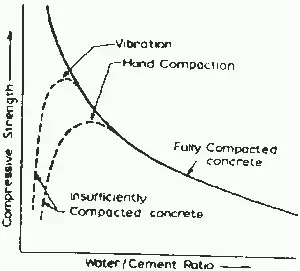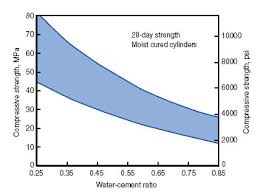Water to cement ratio is ratio between the weight of water and the weight of cement that is used in a fresh concrete mix. Water to cement ratio is one the largest single factor on which strength of compacted concrete depends. Cured concrete strength depends on the two main factors i.e.
- Water to cement ratio
- Degree of compaction
Air voids in concrete depends on the water to cement ratio. There is an increase in air voids with the increase in weight of water. When this situation happens, then strength of concrete drops down. Hardened concrete contains about 1% of air voids. In a hardened state concrete, strength is inversely proportional to the water/cement ratio.
Figure shows that validity range of water to cement ratio is very limited. Compressive strength is at peak, when water to cement ratio is low. Beginning of the curve depends on the available means of compaction (that is either done with vibrators or manually hand compaction). If large size aggregates is used with low water to cement ratio and high contents of cement then it exhibit retrogression of the concrete strength.
A conclusion can be made that if there is a low water to cement ratio in a fresh mix than after hardening, water/cement will not be able to lead higher strength of concrete. These conditions happen because of the development of tensile stresses due to shrinkage and creep. This leads to the cracking of the cement or to the loss bonds (that is between cement and aggregates) as if aggregates try to restrain the tensile stresses.
Therefore, low water to cement ratio leads to serious problems in hardened concrete. When water to cement ratio is low in a fresh mix, then less water is available for the hydration of cement.Hence, some amount of cement paste remains un-hydrated that leads to internally tension in concrete plus weak bond. The strength that might be developed under the current circumstances is much dependent on the following four factors;
- Water to cement ratio
- Cement to aggregate ratio
- Maximum aggregate size
- Physical properties of aggregates
The factors (2,3 and 4) are of lesser importance while factor (1) is the major influencing factor. Because strength of concrete results from the strength of mortar, bond of mortar with aggregates and coarse aggregates strength
Water/cement versus Strength Graph
From the graph, one can see it forms a hyperbola shape. As water to cement ratio is increasing its compressive strength is gradually lacking behind.
Water to Cement Ratio Formulas
Duff Abrams in 1919 presented an equation that relates strength of concrete with water to cement ratio.
Where;
- W/c is the water to cement ratio in the concrete mix.
- K1 and k2 are the empirical constants.
It is very simple relation and it is like the same as presented by Rene Feret in 1896. Both have related volumes of water/cement with strength of concrete.
- fc is the concrete strength.
- w, a, and c are the absolute volumetric proportions of water, air and cement.
- K is the empirical constant.

